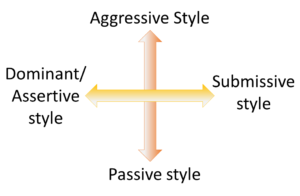
05 Jun The psychology of verbal interaction
Communication is the basis of human and non-human interaction. We can all communicate with a touch or a sound, a look or a symbol, a word or a sentence and also by doing or saying nothing at all. Communication can be verbal and non-verbal and the meaning is best conveyed when all the cues are expressed in synchronicity. However when it involves inexperienced communicators, whose views and beliefs are being shaped and attention is hard to channel, verbal communication plays more influential part.
There are four basic styles of communication, knowledge and management of which can drastically change the quality of the interaction and lead to positive results:

The quality of the style can move along the scale and fluctuate during the conversation, although it is the ability to pull one’s subconscious impulse into the intended direction. By being consistent and assertively dominant in the dialogue, we can evoke a gradual response of mirroring the pace and tone, subsequently leading to agreeableness and more mindful and conscious interaction. When both opponents start slipping into the same style of the verbal expression driven by the flow of the increasing intensity of the emotion, the quality and purpose of the communication becomes distorted and argument escalates to the extent of unnecessary strain for both parties. Or, if it’s taken the opposite way , communication subsides and parties just give up in a futile attempt of being understood.
A good understanding of these styles of communication will help you learn how to react most effectively when confronted with a difficult person. It will also help you recognise when you are not being assertive or not behaving in the most effective way. Remember, you always have a choice as to which communication style you use. Being assertive is usually the most effective but other styles are, of course, necessary in certain situations – such as being submissive when under physical threat (a mugging, hijacking etc.). It is highly important to observe and adjust your style according to the situation.
Focus on the main goal – get your student to hear what you say and absorb all the information to be able to make the right choice, so by guiding them into the right mode/style of communication through adapting yours is the first step to achieve it.
Remember the first rule of effective communication: the success of the communication is the responsibility of the communicator and it is down to us as significant others in lives of our students to take the lead when it comes to maintain or bringing the communication back to the resourceful zone.
Little actions that can help in a big way:
- Use positive and inspiring words and affirmations in any interaction with the young person, consciously paying attention and verbally expressing understanding of their response and feelings.
- Be clear, specific and reassuring in any given praise or any arising argument.
- Replace DON’Ts with Do’s – i.e. “Don’t get upset/agitated– It’s okay to feel that, but think of…”; Don’t say that – please choose another word”.
- Mindfully observe any escalation of your own emotion to be able to appropriately manage it, remember you want a child to mirror you, no other way round.
- Consciously adapt and manage your communication style to foster fertile ground for the perception of the information evoking positive intended change.
- Be as specific as you can in order to convey your message the way you would like it to be perceived, shape up the information to be presented in detail avoiding assumptions from the other party and thus any possible
misinterpretation and misunderstanding. - It is very important for us as adults, teachers, life coaches and significant others in the life of a young mind to stay calm and consistent; to be able to get that vital message across to inspire change for better. By maintaining our position on the same level of the scale we show respect and at the same time confidence in our beliefs, giving an example to a young person. Remember, in any conflict a young opponent’s response is subconscious and driven by raw emotion, they express themselves their best way to let you know how they feel in the way they know, the way that has worked for them so many times before, but for us it may be really confusing and seem to mean purposeful manipulation or misbehaviour.
Next time: The role of positive psychology for well-being.


